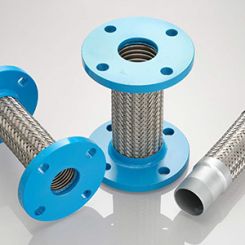Rigorous temperature, pressure and exposure conditions must be met.
Trelleborg Sealing Solutions
12/10/2018
As the subsea industry evolves to help meet the demands of oil field operators, there is now a greater requirement for groundbreaking sealing technology. Oil and gas exploration continues its move to greater subsea depths and this has put an increased emphasis on enhanced oil recovery (EOR) processes to extend global oil reserves. It is a high priority for oil and gas operators to achieve the greatest yield from these wells.
Meeting HP/HT & Safety Demands
Unconventional wells are essentially any reservoir that requires special recovery operations outside the traditional operating practices. In the past, these wells were thought to be too deep for existing technology. However, this is more frequently undertaken and the associated subsea intervention needs to be more sophisticated than previous attempts. Image 1. Sealing systems are key to preventing fluid contamination. (Images courtesy of Trelleborg Sealing Solutions)
Image 1. Sealing systems are key to preventing fluid contamination. (Images courtesy of Trelleborg Sealing Solutions)Controlling Rapid Gas Decompression
Not all standard sealing solutions and materials withstand the extreme operating temperatures and pressures of drilling in greater water depths and reaching deeper into the reserves. Therefore, specialized solutions in both material and seal profile technology are required for the industry to start exploring unconventional wells. New material and product solutions have come onto the market that focus on specific oil and gas issues such as rapid gas decompression (RGD). This phenomenon occurs when an elastomer has been subject to high pressures for a sustained period of time, driving gas deep into the structure of the polymer. If the system pressure is then quickly released, this trapped gas can expand significantly before it has a chance to escape from the material matrix, potentially damaging elastomer seals by ripping them apart from the inside. Special compounds from hydrogenated nitrile butadiene rubber (HNBR) to fluoroelastomer (FKM) to tetrafluoroethlyne/propylene copolymer and perfluoroelastomer (FFKM) are available for RGD resistance. These newly produced elastomer materials feature low compression set characteristics. This material property is particularly relevant to EOR applications, where seals may be required to function for much longer durations than in traditional interventions, while at the same time managing HP/HT conditions. The ability of the elastomer to resist compression set and maintain a large degree of the latent internal sealing forces is critical to ensuring that the seal continues to function correctly across the range of energizing pressures for extended tool operating lifetimes. Specifically engineered for the offshore and subsea industry, the materials match up to the most demanding of upstream requirements and are suited for challenging EOR systems.Going Beyond the Requirements
While recognizing the traditional standards used in the industry, such as American Petroleum Institute (API) 6A, International Organization for Standardization (ISO) 23936, Norsok M710 etc., and having a portfolio of materials that satisfy these specific applications sometimes requires materials that go beyond the traditional standards. These are particularly prevalent when dealing with unconventional wells and often require tailored materials. Applications may have exceptionally high methane content in the well or a focus on compression set properties at high temperatures for long endurance capability. Some specialist HNBR materials exhibit low temperature sealing performance, making them suitable for use within high pressure/low temperature applications. These materials can be ideal where equipment is stored topside in cold climates and then sent downhole, where pressures rise quickly but the equipment temperature increase lags behind. The influence of pressure on the glass transition/cold temperature flexibility of an elastomer can have serious consequences to the performance of seals in such applications. Furthermore, HNBR materials exhibit superior low compression set performance and high temperature sealing capability, making them suitable for operating with extended lifetimes in aggressive well environments. Additionally, high mechanical strength HNBR grades provide outstanding wear and abrasion capabilities, yielding positive results for use in dynamic applications while under higher pressure and temperature conditions. Image 2. Seals are critical elements within oil and gas systems.
Image 2. Seals are critical elements within oil and gas systems.
